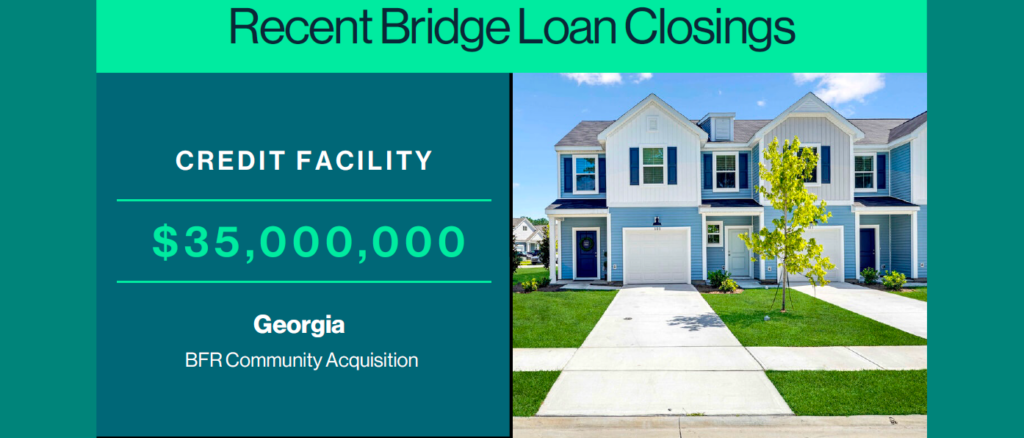Build For Rent (BFR), the construction of new single-family homes specifically for rental purposes, caters to the increasing demand for privacy, spacious living, larger outdoor areas, and adaptable home offices. This fast-growing real estate asset class is reshaping development strategies, prompting both multifamily developers and traditional homebuilders to pivot towards the single-family rental (SFR) market with an eye on increased tenant demand and longer tenant retention.
The BFR movement has given rise to various strategic approaches. One noteworthy strategy involves selling newly built rental homes to institutional investors immediately after receiving a certificate of occupancy. These investors, drawn to the SFR market, prefer acquiring portfolios of new single-family homes in bulk, which they often achieve through collaborative partnerships with home builders. This arrangement benefits builders by reducing risk through pre-sales, while investors gain high-quality SFR properties without the hassle of individual acquisitions.
If you are considering a similar exit strategy or seeking financing for your BFR project, here are some key financing tips to keep in mind.
Beyond interest rates, loan amounts, and recourse options, two additional factors are critical when evaluating construction financing: 1) Lock-out / Prepayment penalties and 2) Servicing.
Lock-out/Prepayment Penalties
Borrowers and lenders often have differing incentives: while borrowers aim to complete projects and repay loans swiftly, lenders benefit from keeping the loan outstanding in order to earn more interest.
This misalignment can lead lenders to impose lockout periods (during which loans cannot be repaid) or prepayment penalties, essentially penalizing borrowers for early project completion. If your plan involves selling or refinancing homes upon obtaining certificates of occupancy, ensure your lender permits penalty-free loan repayment.
Construction Servicing Team
Consider who will handle your draw requests, release of homes, and other loan-related issues. An external servicing team (aka “middleperson”) can introduce delays and inefficiencies, often leading to frustrations such as rigid adherence to loan agreements without flexibility.
For instance, if you need to shift funds from one line item to another, you might encounter the common response, “That’s not what the loan agreement specifies,” initiating a lengthy and cumbersome process with your lender through a third party. Conversely, lenders with internal servicing teams typically offer enhanced communication, greater flexibility, and a stronger overall relationship.
Lending is a relationship business, so lenders are often more inclined to help clients overcome issues during the loan term, which can keep your project on track and ensure timely completion.
With the influx of new institutional and retail investors into the Build For Rent sector, we can anticipate further innovative strategies enhancing the BFR model.
I hope you found this article helpful. Whether you are developing BFR communities, renovating multifamily properties, or expanding your SFR portfolio, I want to hear from you!
Please reach out to Brandon Turk ([email protected]) to discuss potential loan opportunities.
BFR Highlights: Daphne, AL

This bridge loan enables for the acquisition of a 141-unit build for rent community in Alabama. The loan enables the sponsor group to acquire the newly completed homes in phases as units receive their certificates of occupancy.

BFR Highlights: Pooler, GA

This bridge loan enables for the acquisition of a 143-unit build for rent community in Georgia. The loan enables the sponsor group to acquire the newly completed homes in phases as units receive their certificates of occupancy.








Encore Finance’s CEO, Elizabeth (Beth) O’Brien was recently interviewed by How I Met My Data, where they unravel the stories behind data-driven leadership journeys that are shaping the future of business.
Beth’s journey into the world of data began with a love affair sparked in high school math classes. She reflects on the clarity and precision that math offered amidst the tumultuous landscape of adolescence. This early exposure to problem-solving ignited a passion for data analysis that would become the cornerstone of her career.
As Beth transitioned into the corporate world, she quickly recognized the pivotal role of data in driving business outcomes. Managing various divisions within companies, she witnessed firsthand the symbiotic relationship between measurement and management. However, it was the advent of data visualization tools that truly revolutionized her approach, unlocking new dimensions of understanding and decision-making.
Beth’s insights extend beyond internal datasets to the vast realm of external data sources. She shares her experiences navigating the labyrinth of publicly available mortgage data, stressing the importance of consumability and relevance over sheer volume. By harnessing external data effectively, Beth exemplifies how CEOs can extract invaluable insights to steer their organizations towards success.
For CEOs looking to foster a data-driven culture within their organizations, Beth underscores the significance of measurability and transparency. By showcasing the tangible benefits of data-driven decision-making and encouraging a culture of openness to insights, leaders can catalyze a transformative shift in organizational dynamics.
To CEOs hesitant about embracing data, Beth offers a poignant yet straightforward piece of advice: visualize the numbers. By rendering data in accessible formats such as charts and graphs, leaders can unlock profound insights and foster a newfound appreciation for its transformative potential.
Beth O’Brien’s journey epitomizes the transformative power of data in modern leadership. Through her rich anecdotes and pragmatic wisdom, she underscores the indispensable role of data in driving informed decision-making and nurturing a culture of continuous improvement.
Watch the interview here: https://beekin.co/resources/insights/interview-with-beth-obrien/
Back in March 2020, I was interviewed by the Originate Report Team at Geraci Law Firm about my experience as an entrepreneur. Specifically, what lessons I had learned and what I would pass along to other entrepreneurs at the beginning of their journey.
I recently came across the original article posted on the Geraci website, and I was musing about how I would answer the same questions today. While there would be a few tweaks here and there, for the most part my answers would be very similar.
Here are the Cliff’s Notes from that interview. The original article is linked at the bottom.
How I knew I had the right idea with my first business:
I knew because I interacted with my market face to face. My first lending business was AuctionFinance.com. I went to the live auctions and checked in the bidders at the registration table. After just a few days of counting the cashier’s checks as people came in, I knew exactly how much cash was in the room and exactly what I could do to help the bidders.
The best and worst pieces of advice I’ve ever received:
Best: Don’t be afraid to fail.
Worst: Try not to fail.
What I’ve learned from failure:
That failure is fine, but you need to have the ability to pivot quickly when things don’t work out as planned (and they never really work out exactly as planned).
How I built the customer base for my early ventures:
Going to where the customers are and talking to them. There is no substitute for being a great listener. Really engage with them and think critically about how you can address their problems.
The most difficult part of my startup journey and how I worked through it:
I’m pretty methodical and conservative about building a business sustainably. I never want to get too far out over my skis. This was hardest when I watched some of my aggressive competitors building much faster than I was. But I was able to stick to my guns, and in the end it worked out much better for me – I never went through the pain those competitors did of closing doors and laying people off.
My favorite aspect of being an entrepreneur:
Making decisions and watching them play out. There is so much pleasure in setting destiny!
My advice to someone starting their first business:
Make sure you are addressing a real need and listening to your clients along the way.
My typical day:
I don’t have one! That’s the best part.
adfasdf
